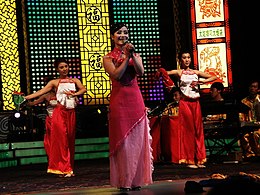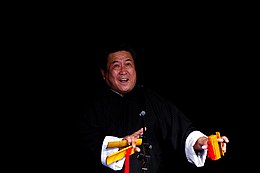| Quyi | |||||||
|---|---|---|---|---|---|---|---|
| Traditional Chinese | 曲藝 | ||||||
| Simplified Chinese | 曲艺 | ||||||
| Literal meaning | melody art | ||||||
| |||||||
| Shuochang yishu | |||||||
| Traditional Chinese | 說唱藝術 | ||||||
| Simplified Chinese | 说唱艺术 | ||||||
| Literal meaning | speak sing art | ||||||
| |||||||
 Xiangsheng
Xiangsheng Nanjing baiju
Nanjing baiju Suzhou pingtan
Suzhou pingtan Errenzhuan
Errenzhuan Kuaibanshu
Kuaibanshu
Quyi ("melodious art") and shuochang yishu ("speaking and singing art") are umbrella terms for over 300 regional genres of traditional Chinese oral performing arts. Quyi is distinguished from xiqu (Chinese opera) by its emphasis on narration, as opposed to acting, although they share many elements including the same traditional stories. Quyi artists generally wear no to little makeup. Musical instruments like drums, wooden clappers, pipa, yangqin, or sanxian are commonly seen in quyi, as are hand fans.
History
While the storytelling art concept has been around for centuries, the narrative art concept was mostly recognized in the 1920s. Only after 1949 with the founding of the People's Republic of China did the term quyi become widely used. Prior to this, it was just classified as shuochang yishu. This is one of the art category that gained momentum since the New Culture Movement. With the exception of the Cultural Revolution period, a great number of stories written for this art are preserved.
Presentation
The story is usually told by a small number of people. The most standard number is 1 or 2, sometimes extending to 4 or higher. Quyi is often accompanied by clappers, drums, or stringed instruments, with the presenter wearing costumes at times. Unlike Chinese operas which has a fixed style for costume, quyi costumes vary depending on the era of the story plot. Costumes range from dynastic period hanfu to the more modern qipao or even suits.
The language used is usually associated with the spoken dialect of the local area. Sometimes it uses rhymed verse, some in prose, and some combine both. A lot of body movements may be used in the portrayal of the characters in the story. Each person may play multiple roles for multiple characters in the story. It is also this local and regional feel for the art that some would classify it as Chinese folk art.
Regions
Outside of mainland China, this entertainment form is also found in Taiwan.
Varieties
- Baiju (白局) - Nanjing
- Dagu (大鼓)
- Danxian (单弦) – Beijing zh
- Kuaiban (快板)
- Pinghua (评话)
- Pingshu (评书)
- Pingtan (评弹)
- Shuoshu (说书)
- Tanci (弹词)
- Xiangsheng (相声)
- Xiangshu (相書)
- Yangzhou pinghua (扬州评话) – Yangzhou, Jiangsu
- Zhuizi – Henan
- Suzhou Pingtan sample
References
- ^ Børdahl, Vibeke (1996). The Oral Tradition of Yangzhou Storytelling. Routledge. pp. 2–4. ISBN 0-7007-0436-1.
- Duchesne, Isabelle (2005). "Quyi". In Davis, Edward L. (ed.). Encyclopedia of Contemporary Chinese Culture. Routledge. p. 690–692. ISBN 0-203-64506-5.
| Chinese opera and Chinese narrative traditions | |||||
|---|---|---|---|---|---|
| Dramatic theater |
| ||||
| Religious theater | |||||
| Comedic/Light theater | |||||
| Quyi (narrative) | |||||
| Historical | |||||
| Role types | |||||
| Costumes | |||||
| Related topics | |||||